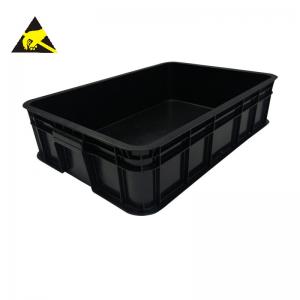

Add to Cart
ESD (Electrostatic Discharge) storage boxes, also known as ESD bins
or ESD containers, are specially designed containers used to store
and protect electronic components and devices from electrostatic
damage. These boxes are constructed with materials that provide ESD
protection, ensuring a safe environment for sensitive electronics.
Here are some key features and considerations regarding ESD storage
boxes:
1.ESD Protection: ESD storage boxes are designed to dissipate
static charges and prevent electrostatic discharge. They are
typically made from materials with inherent static-dissipative or
conductive properties, such as conductive polypropylene or
carbon-filled polymers. These materials help to safely channel any
static charges away from the stored components, minimizing the risk
of ESD damage.
2.Shielding Effect: ESD storage boxes often provide some degree of
electromagnetic shielding to protect the contents from external
electromagnetic interference (EMI). This shielding helps to prevent
unwanted electrical signals or electromagnetic radiation from
affecting the stored electronic devices.
3.Size and Configuration: ESD storage boxes come in various sizes
and configurations to accommodate different types and sizes of
electronic components. They may have compartments, dividers, or
foam inserts to organize and protect individual items within the
box. Some boxes also feature adjustable partitions or removable
trays to customize the storage space according to specific
requirements.
4.Labeling and Identification: ESD storage boxes often have
labeling or marking options to facilitate easy identification of
the stored components. This can include areas for writing labels or
attaching barcodes, ensuring efficient inventory management and
traceability.
5.Stackability and Nesting: ESD storage boxes are designed to be
stackable to optimize storage space. They usually have interlocking
features or ridges that allow for stable stacking without the risk
of boxes toppling over. Some boxes may also be nestable, meaning
they can be stacked inside one another when empty to save space
during storage or transportation.
6.Compatibility with ESD Standards: ESD storage boxes are typically
manufactured in compliance with industry standards and guidelines
for ESD protection, such as the ANSI/ESD S20.20 or IEC 61340-5-1.
Adhering to these standards ensures that the boxes meet the
necessary requirements for an ESD-safe storage environment.
When using ESD storage boxes, it is important to handle and store
them in an ESD-safe environment. This includes grounding the boxes
and following proper ESD handling procedures, such as wearing ESD
wrist straps or using grounded workstations. Additionally, regular
inspections and maintenance of the boxes should be conducted to
ensure their ongoing effectiveness in providing ESD protection.
| Property | Specification |
|---|---|
| Shape | Square |
| Industrial Use | Consumer Electronics |
| Size | Can Be Customized |
| Color | Black |
| Application | To Storage PCB Boards Or Electronic Components |
| Material | PP Plastic , Injection Molding |
| Product Name | Black Conductive Storage Bins ESD Plastic Box |
| Logo | Acceptable Customer's Logo |
| Voltage Withstand | >1000V |
| Surface Resistance | 10^3~10^5ohms |
Fairtech FR08 Black Conductive Storage Bins ESD Plastic Box is designed to safely store PCB boards or electronic components and protect them from electrostatic discharge. It is made of anti-static plastic material, and its static decay is less than 0.1s. This product is certified by CE and ISO, and its minimum order quantity is 100PCS. Its price ranges from USD0.5 to USD11, and its packaging depends on different quantities. The delivery time is 3-5 days, and payment terms are L/C, D/A, D/P, T/T, Western Union, and MoneyGram. Fairtech offers 10000000 pieces per week. This product is available for glossy lamination and can be printed with customer's logo.
Q1: What are ESD components?
A1: An electrostatic-sensitive device (often abbreviated ESD) is
any component (primarily electrical) which can be damaged by common
static charges which build up on people, tools, and other
non-conductors or semiconductors.
Q2: Why is ESD a problem?
A2: ESD can cause harmful effects of importance in industry,
including explosions in gas, fuel vapor and coal dust, as well as
failure of solid state electronics components such as integrated
circuits. These can suffer permanent damage when subjected to high
voltages.
Q3: What is the risk of ESD?
A3: Electrostatic discharge (ESD) occurs when a non-conducting
surface is rubbed against another and the contacted surfaces are
then parted. ESD can damage or destroy sensitive electronic
components, erase or alter magnetic media, or set off explosions or
fires in flammable environments.
Q4: What is an ESD tray?
A4: ESD Trays are stock and include anti-static and conductive
options. ESD-Safe Trays are used for packaging, shipping, and
storage of small electronic parts, circuit boards, pcb, pcba, &
electronic components.
Q5: What are ESD items?
A5: What Is ESD Equipment? On a basic level, ESD equipment is
anything that could ostensibly be used in an electrostatically
sensitive work environment, such as a manufacturing floor, clean
room, or circuit repair operation.
